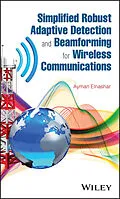This book presents an alternative and simplified approaches for the robust adaptive detection and beamforming in wireless communications. It adopts several systems models including DS/CDMA, OFDM/MIMO with antenna array, and general antenna arrays beamforming model. It presents and analyzes recently developed detection and beamforming algorithms with an emphasis on robustness. In addition, simplified and efficient robust adaptive detection and beamforming techniques are presented and compared with exiting techniques. Practical examples based on the above systems models are provided to exemplify the developed detectors and beamforming algorithms. Moreover, the developed techniques are implemented using MATLAB and the relevant MATLAB scripts are provided to help the readers to develop and analyze the presented algorithms. Simplified Robust Adaptive Detection and Beamforming for Wireless Communications starts by introducing readers to adaptive signal processing and robust adaptive detection. It then goes on to cover Wireless Systems Models. The robust adaptive detectors and beamformers are implemented using the well-known algorithms including LMS, RLS, IQRD-RLS, RSD, BSCMA, CG, and SD. The robust detection and beamforming are derived based on the existing detectors/beamformers including MOE, PLIC, LCCMA, LCMV, MVDR, BSCMA, and MBER. The adopted cost functions include MSE, BER, CM, MV, and SINR/SNR.
Autorentext
Ayman Elnashar, PhD, has 20+ years of experience in the telecoms industry, including 2G/3G/LTE/WiFi/IoT/5G/Wireless Networks. He was part of three major start-up telecom operators in the MENA region (Orange/Egypt, Mobily/KSA, and du/UAE). Currently, he is Head of Core and Cloud planning with the Emirates Integrated Telecommunications Co. "du", UAE. He is the founder of the Terminal Innovation Lab and UAE 5G Innovation Gate (U5GIG). Prior to this, he was Sr. Director Wireless Networks, Terminals and IoT, where he managed and directed the evolution, evaluation, and introduction of du wireless networks, terminals and IoT, including LTE/LTE-A, HSPA+, WiFi, NB-IoT, and is currently working towards deploying 5G network in the UAE.
Inhalt
About the Author xiii
About the Companion Website xiv
1 Introduction 1
1.1 Motivation 1
1.2 Book Overview 4
2 Wireless System Models 13
2.1 Introduction 13
2.1.1 Modulation and Coding Scheme and Link Adaptation 24
2.1.2 Link Adaptation 26
2.2 DS-CDMA Basic Formulation 27
2.2.1 Pulse-shaping Filter 30
2.2.2 Discrete Time Model 30
2.2.3 Channel Model 32
2.2.4 Matrix Formulation for DS/CDMA System Model 38
2.2.5 Synchronous DS/CDMA System 41
2.3 Performance Evaluation 43
2.3.1 Signal to Interference plus Noise Ratio 43
2.3.2 Bit Error Rate 44
2.4 MIMO/OFDM System Model 46
2.4.1 FFT and IFFT 49
2.4.2 Cyclic Prefix 52
2.4.3 Single-user MIMO/OFDM 53
2.4.3.1 3GPP LTE MIMO 55
2.4.4 Adaptive Resource Management 64
2.4.5 Multi-User MIMO/OFDM 69
2.4.6 Adaptive filtering in MIMO/OFDM System 71
2.4.7 Performance Evaluation of MIMO/MBER System 71
2.5 Adaptive Antenna Array 73
2.5.1 Uniform Linear Array 73
2.5.2 DS/CDMA with Antenna Array 78
2.6 Simulation Software 80
References 82
3 Adaptive Detection Algorithms 89
3.1 Introduction 89
3.2 The Conventional Detector 90
3.3 Multiuser Detection 91
3.3.1 Decorrelating Detector 93
3.3.2 Minimum Mean-squared Error Detector 93
3.3.3 Adaptive Detection 95
3.3.4 Blind Detection 95
3.3.4.1 Constrained Optimization 96
3.3.5 Constant Modulus Approach 105
3.3.6 Subspace Approach 107
3.4 Simulation Results 109
3.4.1 Linear Detectors 109
3.4.2 MOE Detectors 111
3.4.2.1 MOE Detector with Single Constraint 111
3.4.2.2 MOE Detector with Multiple Constraints 112
3.4.3 Channel Estimation Techniques 113
3.4.4 LCCMA Detector 115
References 118
4 Robust RLS Adaptive Algorithms 127
4.1 Introduction 127
4.2 IQRD-RLS Algorithm 131
4.3 IQRD-Based Receivers with Fixed Constraints 132
4.3.1 Direct-form MOE Detector 132
4.3.2 MOE Detector based on IQRD-RLS and PLIC 133
4.4 IQRD-based Receiver with Optimized Constraints 135
4.5 Channel Estimation Techniques 139
4.5.1 Noise Cancellation Schemes 139
4.5.1.1 Adaptive Implementation of Improved Cost Function 139
4.5.1.2 Adaptive Implementation of Modified Cost Function 140
4.5.2 Adaptive Implementation of POR Method 141
4.5.3 Adaptive Implementation of Capon Method 142
4.6 New Robust Detection Technique 144
4.7 Systolic Array Implementation 148
4.8 Simulation Results 153
4.8.1 Experiment 1 153
4.8.2 Experiment 2 155
4.8.3 Experiment 3 158
4.8.4 Experiment 4 160
4.8.5 Experiment 5 162
4.9 Complexity Analysis 163
Appendix 4.A Summary of Inverse QR Algorithm with Inverse Updating 167
Appendix 4.B QR Decomposition Algorithms 169
Appendix 4.C Subspace Tracking Algorithms 171
References 173
5 Quadratically Constrained Simplified Robust Adaptive Detection 181
5.1 Introduction 181
5.2 Robust Receiver Design 187
5.2.1 Quadratic Inequality Constraint 187
5.2.1.1 SP Approach 188
5.2.1.2 Tian Approach 189
5.2.1.3 A Simplified VL Approach 191
5.2.2 Optimum Step-size Estimation 194
5.2.3 Low-complexity Recursive Implementation based on PLIC 195
5.2.4 Convergence Analysis 198
5.3 Geometric Approach 199
5.4 Simulation Results 202
5.5 Complexity Analysis 213
Appendix 5.A Robust Recursive Conjugate Gradient (RCG) Algorithm 215
References 217
6 Ro...
